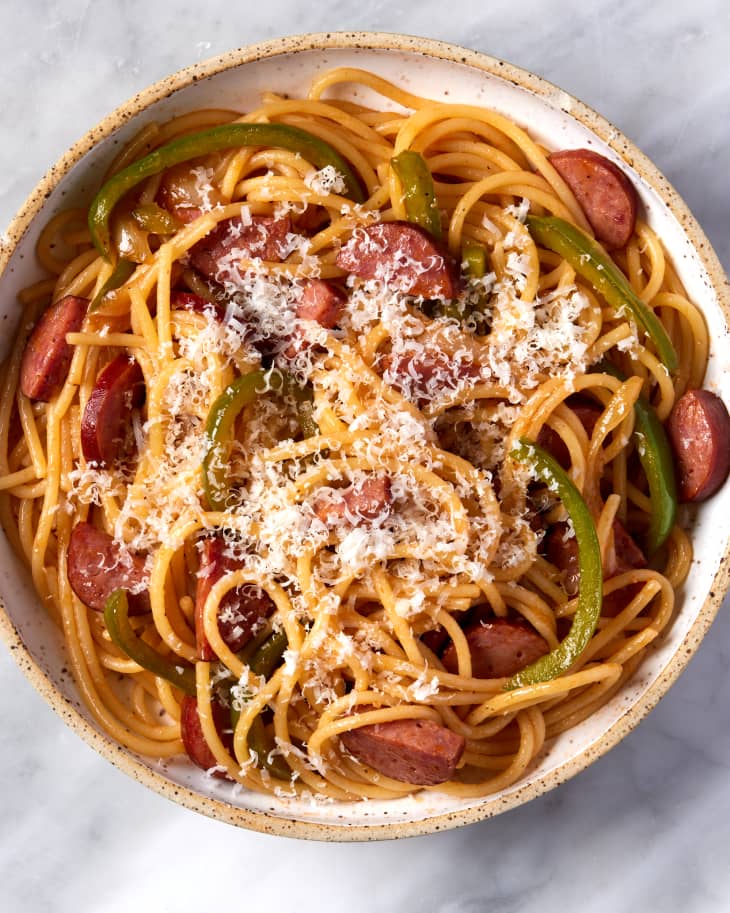Napolitan (Japanese Ketchup Pasta)

This popular Japanese pasta dish with kielbasa, sliced onions, and green bell pepper has one surprising ingredient — ketchup.
Serves4
Prep10 minutes
Cook20 minutes
How do you feel about ketchup on spaghetti? If that sounds delicious to you, then we’re clearly meant to be besties. But if you’re the “no thanks!” type, let me introduce you to a beloved, comforting, and delicious pasta dish that hails from Japan (and can’t be found in Italy), known as napolitan.
I first learned about the dish from one of my favorite food Youtubers, Honeykki. Her relaxing, comforting cooking videos will make you hungry (and for me, they’re the type of food therapy I need every day!). While watching her video, one surprising ingredient caught my eye that I didn’t expect to see: ketchup.
In her video, she sautés sliced onion, pepper, and sausage in a pan with olive oil. Then she adds cooked spaghetti to the pan, along with a generous squeeze of ketchup. The color is so vibrant, and within a few seconds, the spaghetti looks like it’s coated in tomato sauce.
At first, I was skeptical. As a person who always goes for mayo instead of ketchup when eating fries, I’ve never been crazy about ketchup’s tangy, sweet taste. But when I tasted the dish, I understood why she highly recommends it. The taste was both familiar and nostalgic at the same time, even though it was my first time making this recipe. Throwing in soft-yet-crunchy vegetables like bell pepper, onions, and sliced sausages makes each slurp satisfying and hearty.
The Origins of Napolitan
A Japanese chef from Yokohama was credited with creating this dish. He wanted to recreate the spaghetti with tomato sauce that was served to the American military during the 1950s in Japan. But because tomato sauce was a hard-to-find ingredient at the time, he replaced it with ketchup and named it spaghetti Napoli after Naples, Italy. The dish’s name turned into spaghetti napolitan as a result of Japanese translation and pronunciation changes. It’s now one of the most popular pasta dishes in the category of yoshoku, which is known as Western-influenced food in Japan.
How to Make Napolitan
My take on this classic Japanese pasta has a few additions that complement the ketchup’s flavor: kielbasa and oyster sauce. Kielbasa adds more texture and flavor to the pasta than a regular sausage. As for the sweet-and-salty oyster sauce, its addition bumps up the umami flavor and rounds out the ketchup-based sauce.
All in all, it’s a highly flexible, pantry-friendly, and quick-to-make pasta dish guaranteed to make you smile. If you want to make this vegetarian, take out the kielbasa sausage and add mushrooms. If you want to load up with more meat, add bacon on top of the kielbasa. If you want to make it a little spicy, add more hot sauce! As long as you let the ketchup shine through, whatever direction you take with this dish will be delicious. Even if you are a ketchup hater, once you taste this, I bet you’ll make sure to stock it in your fridge so that you can make this dish on rotation.
Napolitan Recipe
This popular Japanese pasta dish with kielbasa, sliced onions, and green bell pepper has one surprising ingredient — ketchup.
Prep time 10 minutes
Cook time 20 minutes
Serves 4
Nutritional Info
Ingredients
- 12 to 13 ounces
kielbasa or other smoked sausage
- 1
medium green bell pepper
- 1/2
medium yellow onion
- 3 cloves
garlic
- 2 tablespoons
unsalted butter, divided
- 1/4 cup
plus 1 tablespoon ketchup, divided
- 2 tablespoons
oyster sauce
- 1 teaspoon
hot sauce, such as Tabasco
- 2 tablespoons
olive oil
- 1/2 teaspoon
kosher salt
- 1/4 teaspoon
freshly ground black pepper
- 1 pound
dried spaghetti
Shaved Parmesan cheese, for garnish
Instructions
Bring a large pot of heavily salted water to a boil over medium-high heat. Meanwhile, prepare the sauce.
Halve 12 to 13 ounces kielbasa lengthwise, then cut crosswise into thin half-moons. Trim and thinly slice 1 medium green bell pepper, 1/2 medium yellow onion, and 3 garlic cloves.
Place 1 tablespoon of the unsalted butter in a small microwave-safe bowl and microwave until melted. Alternatively, melt in a small saucepan on the stovetop. Add 1/4 cup of the ketchup, 2 tablespoons oyster sauce, and 1 teaspoon hot sauce. Stir to combine.
Heat 2 tablespoons olive oil in a large skillet over medium heat until shimmering. Add the garlic and cook, stirring occasionally, until fragrant, about 30 seconds. Add the onion and kielbasa and cook until the onion is slightly translucent, 2 to 3 minutes. Add the bell pepper, season with 1/2 teaspoon kosher salt and 1/4 teaspoon black pepper, and cook until the pepper softens, about 2 minutes.
Push the vegetables to the sides of the pan to make a well in the middle. Pour the ketchup mixture into the well and cook undisturbed until the sauce is lightly caramelized, about 30 seconds. Stir everything together and let simmer until the sauce thickens, 3 to 5 minutes. Remove the pan from the heat.
Meanwhile, add 1 pound dried spaghetti to the boiling water and cook according to package directions until 1 minute less than al dente. Reserve 1 cup of the cooking water. Drain the pasta.
Add the drained pasta and 1/2 cup of the cooking water to the sauce. Toss with tongs over medium-low heat until the sauce coats the noodles. Add the remaining 1 tablespoon unsalted butter and 1 tablespoon ketchup, adding more of the pasta water a tablespoon at a time as needed if the sauce is too thick. Serve garnished with shaved Parmesan cheese.
Recipe Notes
Storage: Leftovers can be refrigerated in an airtight container for up to 3 days.
